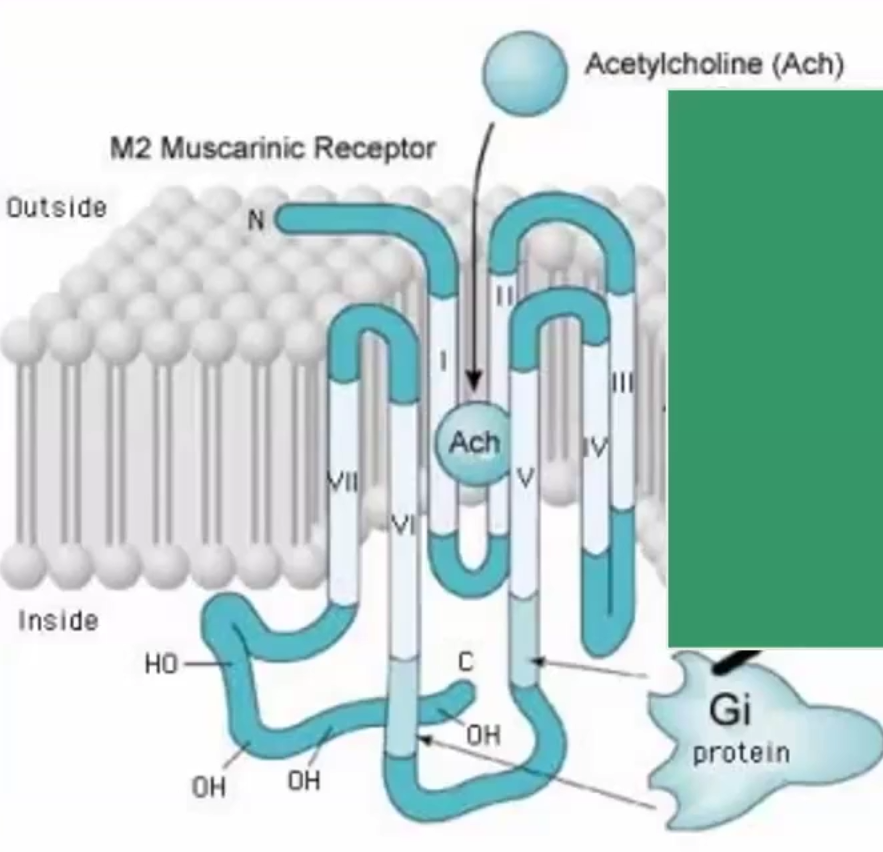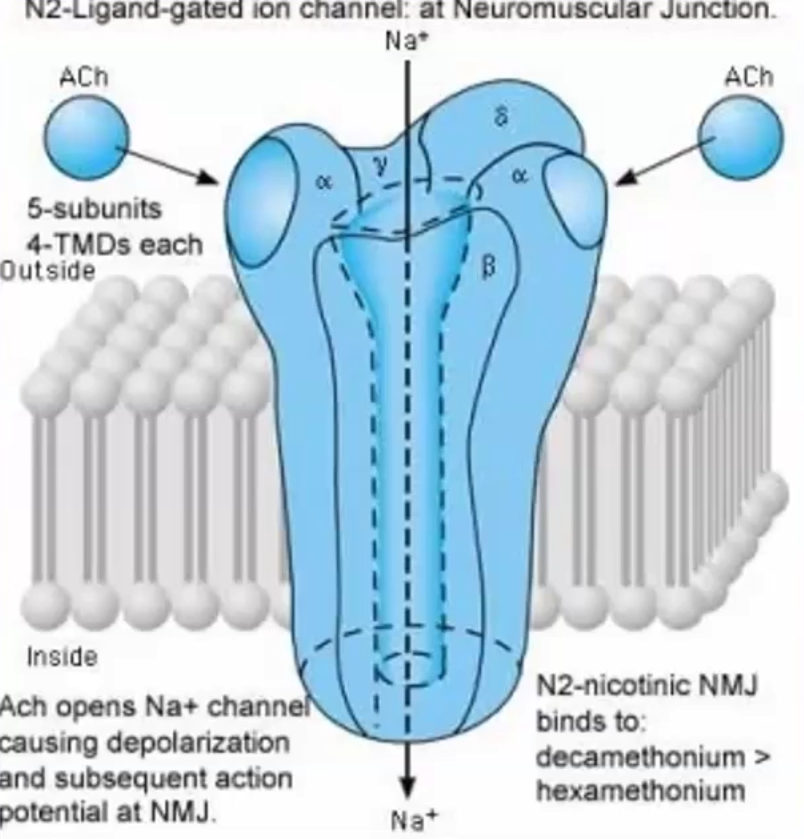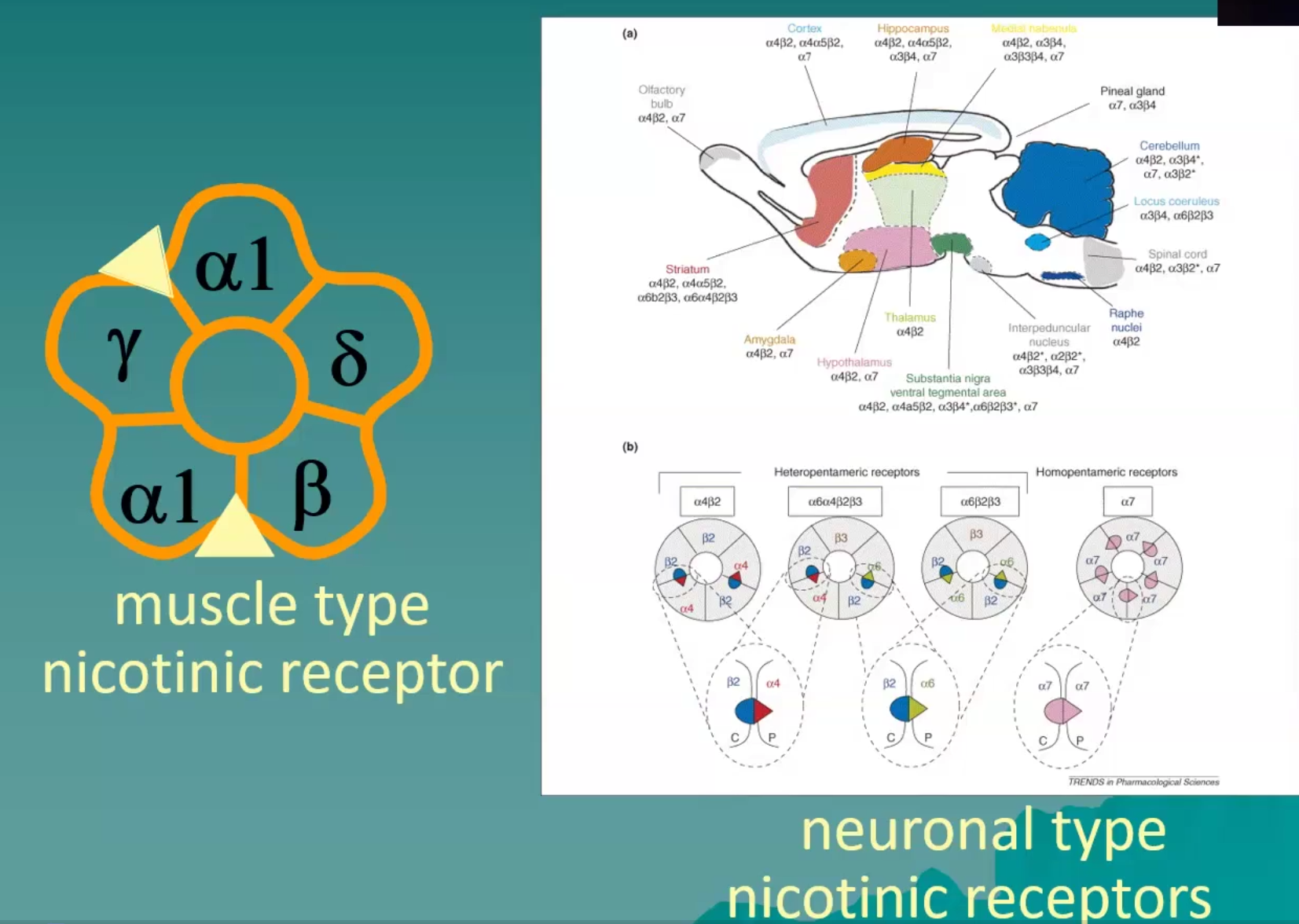Cholinergic Agonists
1/9
There's no tags or description
Looks like no tags are added yet.
Name | Mastery | Learn | Test | Matching | Spaced |
|---|
No study sessions yet.
10 Terms
Muscarinic receptor Structure
M1-M5, M1-3 in ANS
7 transmembrane domains with G-coupled receptors

Nicotinic Receptor Structure
NM for Muscle and NN for ANS
5 Subunit arranged into a membrane channel that opens Na/Ca channels upon binding of 2 ACh molecules


Explain the VERY complex reason why peripheral vasodilation MOSTLY does not occur naturally (except erection that IS innervated) and only through systemically applied cholinergic agonists
Also explain what happens if there is NO endothelium
There is no PNS innervation directly to the endothelium of blood vessels, so they do have M3 but acetylcholine does not reach to activate
Now if you inject a cholinergic agonist here, it will activate M3 receptor to release NO, which travels to M3 receptor on smooth muscle cell and causes vasodilation
If there is no endothelium, injected cholinergic agonists directly bind to M3 receptors and cause vasoconstriction
In diseases where endothelium is damaged, this can be a problem
The CNS has both muscarinic and nicotinic receptors, explain how they act
Muscarinic receptors are mostly involved in the regulation of voluntary movement in basal ganglia
Nicotinic receptors activate both sympathetic and parasympathetic
Sympathomimetic: hypertension, vasoconstriction, tachycardia
Parasympathetic: GI and urinary, followed by inhibition (biphasic
In NMJ: initial uncoordinated muscle contraction, but continued exposure leads to depolarizing blockade and eventually flaccid paralysis (nicotine toxicity)
Organ system effects of muscarinic over-activation
Treatment
Diarrhea
Urination
Miosis
Bradycardia, Bronchoconstriction
Emesis (vomiting)
Lacrimation
Salivation, Sweating
Treatment: muscarinic antagonists such as atropine
Organ system effects of nicotinic over-activation (Biphasic)
Treatment
Muscle weakness
Adrenal medulla activation
Tachycardia
Cramping
Hypertension
Treatment: Maintenance of vitals
Direct Acting Cholinergic Agonists
Name
Action of Drug
Clinical use
All these can be reversed with Atropine!
Esters of Choline
Methacholine (Provocholine) “PROVes bronchial hypersensitivity”
Causes bronchoconstriction, muscarinic selective
Used for diagnosis of bronchial airway hypersensitivity + also used as a miotic agent (pupil constriction)
Carbachol (isopto Carbachol, Miostat)
Significant nicotinic activity, only used in the eye
Used during surgery to induce miosis and reduce rises in intraocular pressure but can cause cardiovascular and GI complications
Bethanechol (Urecholine) “pregnant bethany urinates”
Selective for muscarinic receptors, increases GI tone and motility, promotes emptying of the bladder
Oral or subQ for acute postoperative and post-partum non-obstructive urinary retention
Alkaloids
Muscarine
Activates muscarinic receptors
No clinical use
Pilocarpine (Salagen or Pilocar)
Parasympathomimetic with muscarinic effects and crosses BBB
Induces miosis through contraction of ciliary muscle (reduces IOP), used as a sialagogue for Xerostomia and other systemic effects
Cevimeline (Evoxac) “Evades xerostomia”
M3 agonist
Used for Xerostomia in Sjogren’s syndrome and secondary radiation therapy)
Nicotine (Nicorette, NicoDerm CQ, Commit)
Specific for nicotinic receptors at all autonomic ganglia, increases
Used for patients to commit to tobacco sessation
Varenicline (Chantix) “Psychiatix smokers”
Partial agonist to nicotinic receptors, stops full agonist (nicotine) from binding
Can block effect of a relapse from smoking but can increase psychiatric side effects
Indirect Acting Cholinergic Agonists/ Cholinesterase Inhibitors
Name
Reversible or irreversible
Action of Drug
Clinical use
These can be used to increase strength of contraction of skeletal muscle*****
Reversible
Physostigmine salicylate (Antilirium)
Intermediate duration, crosses BBB
Used for miosis, ciliary paralysis, decreasing IOP, reverses NMJ block, treatment for anti-cholinergic tox, tx for Myasthenia Gravis
Neostigmine (Prostigmin)
Short duration
Used for Myasthenia Gravis, reverse NMJ block, reduce IOP, urinary retention
Pyridostigmine (Mestinon)
neostigmine analog that hs longer duration
Used primarily for Myasthenia Gravis
Donepezil (Aricept):
Long duration, helps with dementia/AD
Rivastigmine (Exelon):
Similar to donepezil but also approved for Parkinson’s related dementia
Pseudo reversible
Irreversible: mostly pesticides and dangerous
Malathion and Parathion:
Used as insecticide, kils fish too
Parathion kills all vertebrates
Treatment: maintain vital signs, atropine and benzos
Sarin, Soman, Vx:
Rapid nerve agent that causes all the DUMBELS effects
Treat with Atropine, Pralidoxime or benzodiazepine
Pralidoxime (Protopam, 2-pam)
Oxime used to regenerate cholinesterase in cases of poisoning with ireversible dugs
High doses can inhibit ACh
Nicotine Toxicity
Symptoms
Treatment
Vomiting, convulsions, coma, death, respiratory failure
Treat with atropine, benzodiazepine and mechanical ventilation